Sungsu Lim
FnRGNN: Distribution-aware Fairness in Graph Neural Network
Oct 22, 2025Abstract:Graph Neural Networks (GNNs) excel at learning from structured data, yet fairness in regression tasks remains underexplored. Existing approaches mainly target classification and representation-level debiasing, which cannot fully address the continuous nature of node-level regression. We propose FnRGNN, a fairness-aware in-processing framework for GNN-based node regression that applies interventions at three levels: (i) structure-level edge reweighting, (ii) representation-level alignment via MMD, and (iii) prediction-level normalization through Sinkhorn-based distribution matching. This multi-level strategy ensures robust fairness under complex graph topologies. Experiments on four real-world datasets demonstrate that FnRGNN reduces group disparities without sacrificing performance. Code is available at https://github.com/sybeam27/FnRGNN.
Zero-Shot Industrial Anomaly Segmentation with Image-Aware Prompt Generation
Apr 18, 2025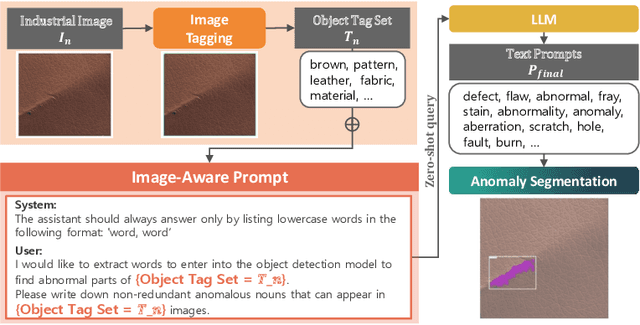
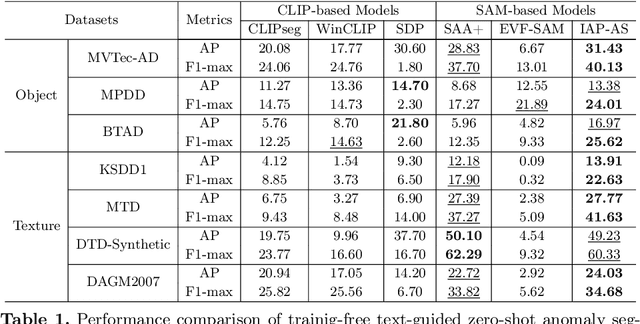
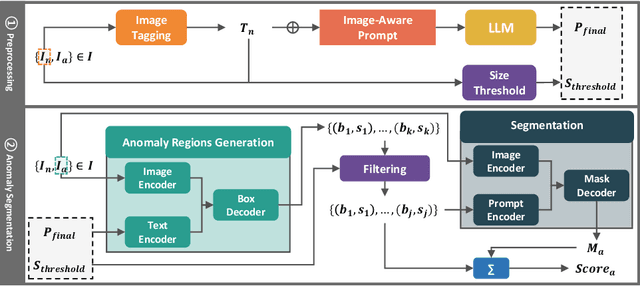

Abstract:Anomaly segmentation is essential for industrial quality, maintenance, and stability. Existing text-guided zero-shot anomaly segmentation models are effective but rely on fixed prompts, limiting adaptability in diverse industrial scenarios. This highlights the need for flexible, context-aware prompting strategies. We propose Image-Aware Prompt Anomaly Segmentation (IAP-AS), which enhances anomaly segmentation by generating dynamic, context-aware prompts using an image tagging model and a large language model (LLM). IAP-AS extracts object attributes from images to generate context-aware prompts, improving adaptability and generalization in dynamic and unstructured industrial environments. In our experiments, IAP-AS improves the F1-max metric by up to 10%, demonstrating superior adaptability and generalization. It provides a scalable solution for anomaly segmentation across industries
Multi-Hyperbolic Space-based Heterogeneous Graph Attention Network
Nov 18, 2024Abstract:To leverage the complex structures within heterogeneous graphs, recent studies on heterogeneous graph embedding use a hyperbolic space, characterized by a constant negative curvature and exponentially increasing space, which aligns with the structural properties of heterogeneous graphs. However, despite heterogeneous graphs inherently possessing diverse power-law structures, most hyperbolic heterogeneous graph embedding models use a single hyperbolic space for the entire heterogeneous graph, which may not effectively capture the diverse power-law structures within the heterogeneous graph. To address this limitation, we propose Multi-hyperbolic Space-based heterogeneous Graph Attention Network (MSGAT), which uses multiple hyperbolic spaces to effectively capture diverse power-law structures within heterogeneous graphs. We conduct comprehensive experiments to evaluate the effectiveness of MSGAT. The experimental results demonstrate that MSGAT outperforms state-of-the-art baselines in various graph machine learning tasks, effectively capturing the complex structures of heterogeneous graphs.
ANOMIX: A Simple yet Effective Hard Negative Generation via Mixing for Graph Anomaly Detection
Oct 27, 2024



Abstract:Graph contrastive learning (GCL) generally requires a large number of samples. The one of the effective ways to reduce the number of samples is using hard negatives (e.g., Mixup). Designing mixing-based approach for GAD can be difficult due to imbalanced data or limited number of anomalies. We propose ANOMIX, a framework that consists of a novel graph mixing approach, ANOMIX-M, and multi-level contrasts for GAD. ANOMIX-M can effectively mix abnormality and normality from input graph to generate hard negatives, which are important for efficient GCL. ANOMIX is (a) A first mixing approach: firstly attempting graph mixing to generate hard negatives for GAD task and node- and subgraph-level contrasts to distinguish underlying anomalies. (b) Accurate: winning the highest AUC, up to 5.49% higher and 1.76% faster. (c) Effective: reducing the number of samples nearly 80% in GCL. Code is available at https://github.com/missinghwan/ANOMIX.
Hyperbolic Heterogeneous Graph Attention Networks
Apr 15, 2024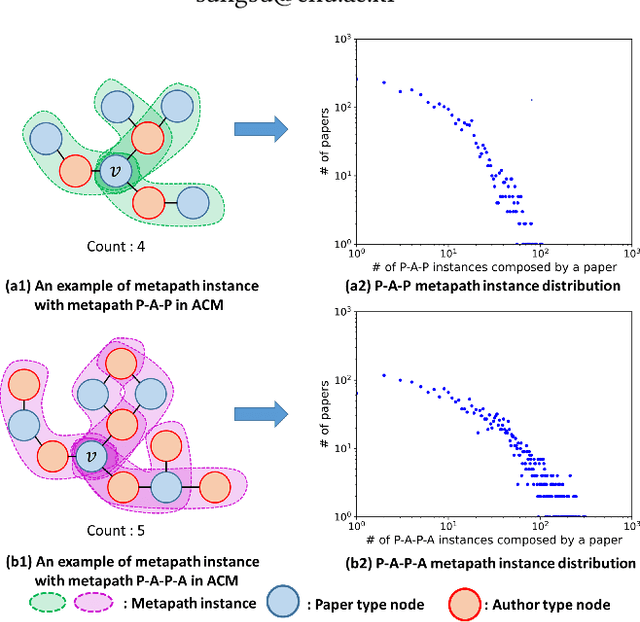
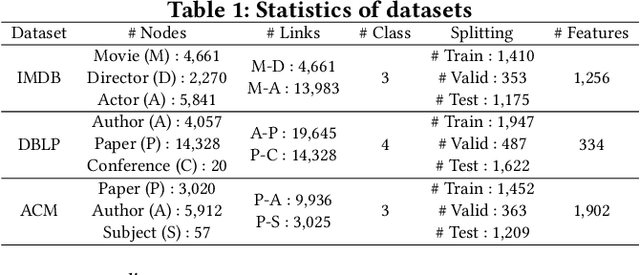
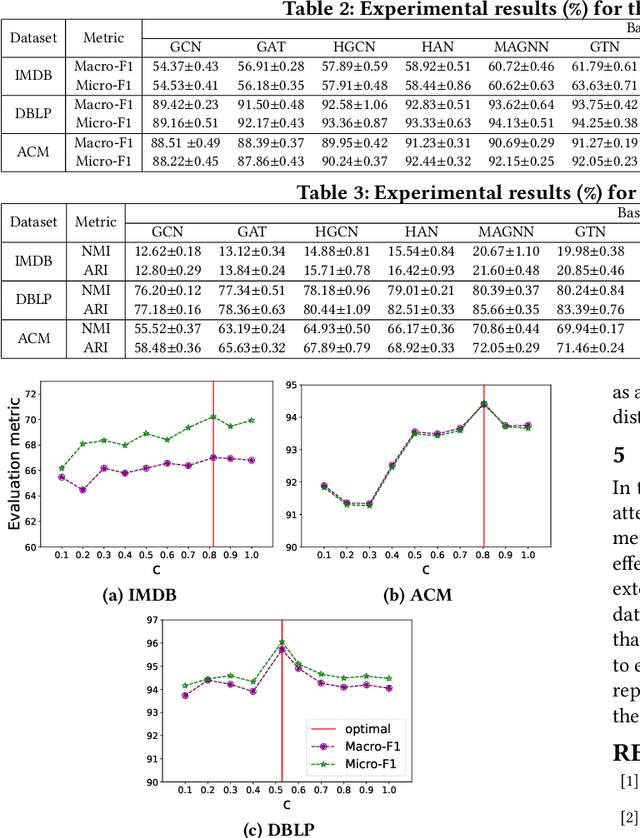
Abstract:Most previous heterogeneous graph embedding models represent elements in a heterogeneous graph as vector representations in a low-dimensional Euclidean space. However, because heterogeneous graphs inherently possess complex structures, such as hierarchical or power-law structures, distortions can occur when representing them in Euclidean space. To overcome this limitation, we propose Hyperbolic Heterogeneous Graph Attention Networks (HHGAT) that learn vector representations in hyperbolic spaces with meta-path instances. We conducted experiments on three real-world heterogeneous graph datasets, demonstrating that HHGAT outperforms state-of-the-art heterogeneous graph embedding models in node classification and clustering tasks.
Deep Semi-supervised Anomaly Detection with Metapath-based Context Knowledge
Aug 21, 2023



Abstract:Graph anomaly detection has attracted considerable attention in recent years. This paper introduces a novel approach that leverages metapath-based semi-supervised learning, addressing the limitations of previous methods. We present a new framework, Metapath-based Semi-supervised Anomaly Detection (MSAD), incorporating GCN layers in both the encoder and decoder to efficiently propagate context information between abnormal and normal nodes. The design of metapath-based context information and a specifically crafted anomaly community enhance the process of learning differences in structures and attributes, both globally and locally. Through a comprehensive set of experiments conducted on seven real-world networks, this paper demonstrates the superiority of the MSAD method compared to state-of-the-art techniques. The promising results of this study pave the way for future investigations, focusing on the optimization and analysis of metapath patterns to further enhance the effectiveness of anomaly detection on attributed networks.
A Unified Compression Framework for Efficient Speech-Driven Talking-Face Generation
Apr 02, 2023Abstract:Virtual humans have gained considerable attention in numerous industries, e.g., entertainment and e-commerce. As a core technology, synthesizing photorealistic face frames from target speech and facial identity has been actively studied with generative adversarial networks. Despite remarkable results of modern talking-face generation models, they often entail high computational burdens, which limit their efficient deployment. This study aims to develop a lightweight model for speech-driven talking-face synthesis. We build a compact generator by removing the residual blocks and reducing the channel width from Wav2Lip, a popular talking-face generator. We also present a knowledge distillation scheme to stably yet effectively train the small-capacity generator without adversarial learning. We reduce the number of parameters and MACs by 28$\times$ while retaining the performance of the original model. Moreover, to alleviate a severe performance drop when converting the whole generator to INT8 precision, we adopt a selective quantization method that uses FP16 for the quantization-sensitive layers and INT8 for the other layers. Using this mixed precision, we achieve up to a 19$\times$ speedup on edge GPUs without noticeably compromising the generation quality.
Graph Anomaly Detection with Graph Neural Networks: Current Status and Challenges
Oct 04, 2022

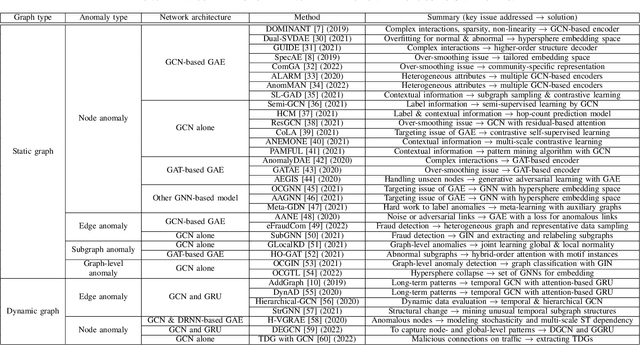
Abstract:Graphs are used widely to model complex systems, and detecting anomalies in a graph is an important task in the analysis of complex systems. Graph anomalies are patterns in a graph that do not conform to normal patterns expected of the attributes and/or structures of the graph. In recent years, graph neural networks (GNNs) have been studied extensively and have successfully performed difficult machine learning tasks in node classification, link prediction, and graph classification thanks to the highly expressive capability via message passing in effectively learning graph representations. To solve the graph anomaly detection problem, GNN-based methods leverage information about the graph attributes (or features) and/or structures to learn to score anomalies appropriately. In this survey, we review the recent advances made in detecting graph anomalies using GNN models. Specifically, we summarize GNN-based methods according to the graph type (i.e., static and dynamic), the anomaly type (i.e., node, edge, subgraph, and whole graph), and the network architecture (e.g., graph autoencoder, graph convolutional network). To the best of our knowledge, this survey is the first comprehensive review of graph anomaly detection methods based on GNNs.
SiReN: Sign-Aware Recommendation Using Graph Neural Networks
Aug 19, 2021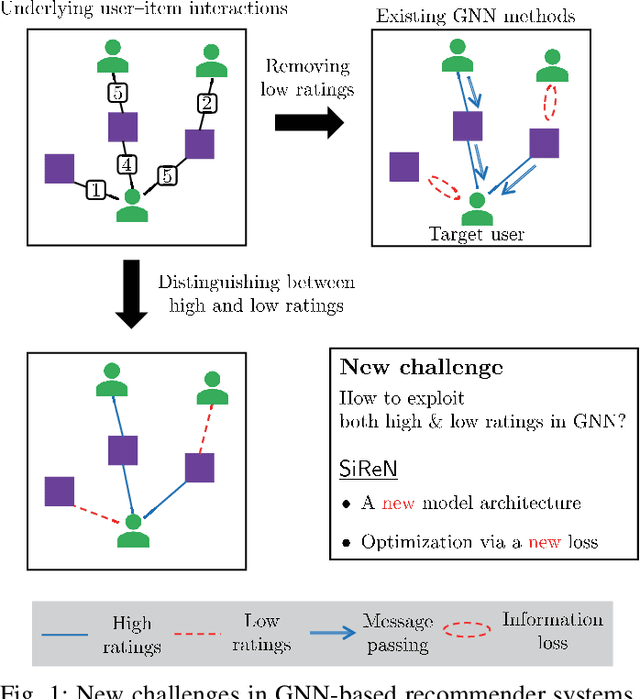
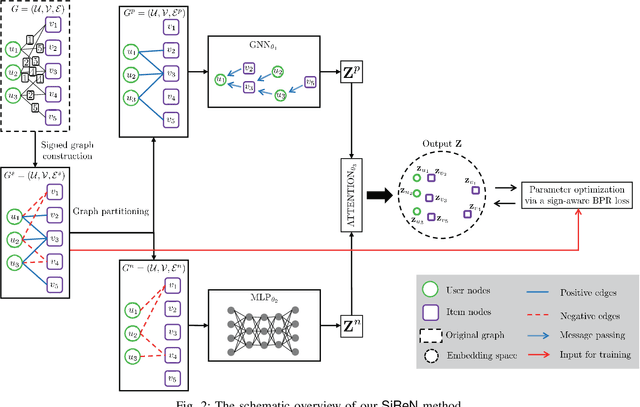
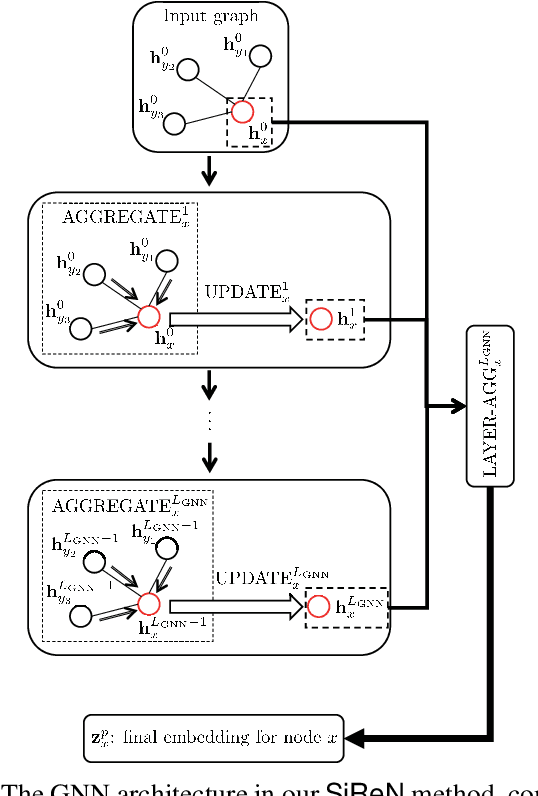
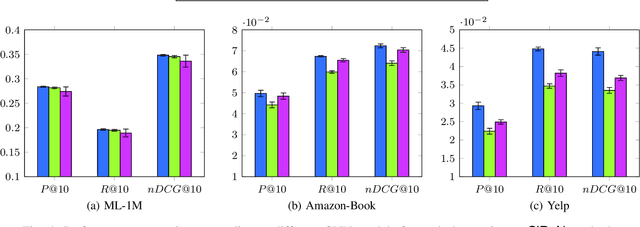
Abstract:In recent years, many recommender systems using network embedding (NE) such as graph neural networks (GNNs) have been extensively studied in the sense of improving recommendation accuracy. However, such attempts have focused mostly on utilizing only the information of positive user-item interactions with high ratings. Thus, there is a challenge on how to make use of low rating scores for representing users' preferences since low ratings can be still informative in designing NE-based recommender systems. In this study, we present SiReN, a new sign-aware recommender system based on GNN models. Specifically, SiReN has three key components: 1) constructing a signed bipartite graph for more precisely representing users' preferences, which is split into two edge-disjoint graphs with positive and negative edges each, 2) generating two embeddings for the partitioned graphs with positive and negative edges via a GNN model and a multi-layer perceptron (MLP), respectively, and then using an attention model to obtain the final embeddings, and 3) establishing a sign-aware Bayesian personalized ranking (BPR) loss function in the process of optimization. Through comprehensive experiments, we empirically demonstrate that SiReN consistently outperforms state-of-the-art NE-aided recommendation methods.
Greedification Operators for Policy Optimization: Investigating Forward and Reverse KL Divergences
Jul 17, 2021
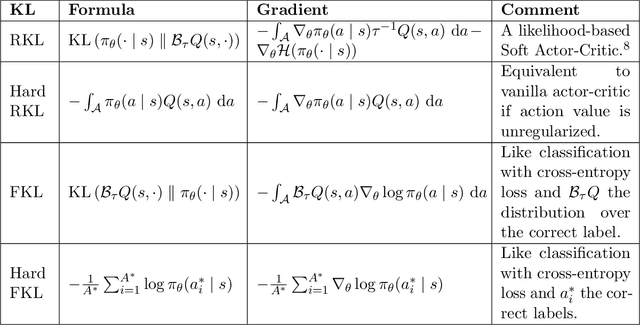


Abstract:Approximate Policy Iteration (API) algorithms alternate between (approximate) policy evaluation and (approximate) greedification. Many different approaches have been explored for approximate policy evaluation, but less is understood about approximate greedification and what choices guarantee policy improvement. In this work, we investigate approximate greedification when reducing the KL divergence between the parameterized policy and the Boltzmann distribution over action values. In particular, we investigate the difference between the forward and reverse KL divergences, with varying degrees of entropy regularization. We show that the reverse KL has stronger policy improvement guarantees, but that reducing the forward KL can result in a worse policy. We also demonstrate, however, that a large enough reduction of the forward KL can induce improvement under additional assumptions. Empirically, we show on simple continuous-action environments that the forward KL can induce more exploration, but at the cost of a more suboptimal policy. No significant differences were observed in the discrete-action setting or on a suite of benchmark problems. Throughout, we highlight that many policy gradient methods can be seen as an instance of API, with either the forward or reverse KL for the policy update, and discuss next steps for understanding and improving our policy optimization algorithms.
 Add to Chrome
Add to Chrome Add to Firefox
Add to Firefox Add to Edge
Add to Edge